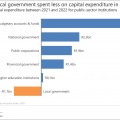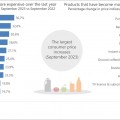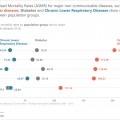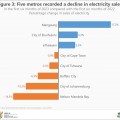
Public-sector capital expenditure increases in 2022
After five consecutive years of decline, capital expenditure in the public sector increased by R9,3 billion (4,6%), from R199,8 billion in 2021 to R209,1 billion in 2022. Extra-budgetary accounts and funds, national government, public corporations, provincial government and higher education institutions all recorded increases. However, there was a decline for local government, according to Stats SA’s Capital expenditure read more »
Eastern Cape home to over 7.2 million people.
Eastern Cape is the fourth most populated province in South Africa, according to the latest Census 2022 results. The total population of Eastern Cape as counted in Census 2022 increased by 10, 2% from 6,5 million more than a decade ago in Census 2011 to 7,2 million in the latest population and housing census. A read more »
Free State home to over 2,9 million people.
Media Release For Immediate Release 18 October 2023 Free State home to over 2,9 million people. Free State is one of the smaller provinces in South Africa, ranked eighth according to the latest Census 2022 results. The total population of Free State as counted in Census 2022 increased by 8,0%, from 2,7m more than a read more »

Inflation rises for a second consecutive month
Consumer price inflation increased to 5,4% in September from 4,8% in August. This brings the rate to the same level as June this year. Fuel prices cast a shadow The fuel index increased for a second consecutive month, rising by 7,6% between August and September. The price of inland 95-octane petrol jumped by R1,71 in read more »
Mbalo Brief – October 2023
On the 10th of October 2023, Statistics South Africa (Stats SA) published the results of Census 2022. The latest census results show that the South African population grew to 62 million in 2022. Gauteng and KwaZulu-Natal continued to be the provinces with the largest population, at 15,1 million and 12,4 million, respectively. While Western Cape read more »

Rising Non-Communicable Diseases: A Looming Health Crisis
Non-communicable diseases (NCDs) have emerged as a major global health challenge, affecting millions of individuals worldwide. A new report released by Statistics South Africa (Stats SA), Non-communicable diseases: Findings from death notifications (2008-2018), explores the changing landscape of NCDs in South Africa over time, highlighting key trends and insights. Data from the World Health Organization read more »

Electricity: a vital resource for municipalities
Municipalities generate most of their revenue from electricity sales. Those involved in providing services buy electricity from producers (such as Eskom) and then resell the power to households, businesses and other institutions. The resulting surplus from this trade is a vital source of income. Electricity’s contribution to revenue Municipalities spent R50,2 billion on electricity purchases in read more »
MEDIA RELEASE: Census 2022 Population Count Results 10 October 2023
Background Census 2022 was the fourth census after the advent of democracy, with the other three being conducted in 1996, 2001 and 2011. This was the first-ever digital census in South Africa. Census information was collected via a digital questionnaire, using three modes of collection: Computer-assisted Personal Interview (CAPI), where fieldworkers visited households and conducted read more »
Census 2022 shows South Africa’s population grew to 62 million
The latest Census results show that the South African population grew to 62 million in 2022. Gauteng remained the province with the highest population (15 million), while Northern Cape has the smallest population at 1,3 million. The Western Cape has moved from being the 5th-largest province in terms of population size in 1996 to being read more »
The Statistician-General of South Africa, Mr Risenga Maluleke, will hand over the Census 2022 national results to President Cyril Ramaphosa at a media launch to be held on Tuesday, 10 October 2023 in Pretoria.
The Statistician-General of South Africa, Mr Risenga Maluleke, will hand over the Census 2022 national results to President Cyril Ramaphosa at a media launch to be held on Tuesday, 10 October 2023 in Pretoria. Census data is an important data source used for planning and evidence based decision making by government and various sectors of read more »

